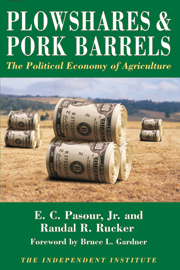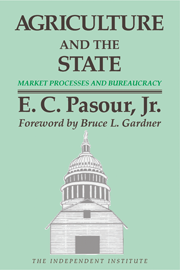The price of the new farm bill, final details of which are being hammered out by congressional negotiators, has risen to $280 billion over five years, according to news reports.
“The proposal includes provisions encouraging investment in biofuels and wind energy, help for retired and disabled farmers, and a faster tax write-off for owners of racehorses, among other things,” writes Greg Hitt in the Wall Street Journal.
In short, there is something for almost everyone involved in agriculture. But what about consumers? They often pay twice: first, in higher grocery prices, and second, through an array of tax-financed subsidies.
Politicians claim to be friends of the small “family farmer,” but most government payments go to large farms, with the largest 9% of all U.S. farms (with revenue above $250,000) getting 56% of all payments under the current bill, enacted in 2002.
More than half of U.S. farms receive no payments at all, because they don’t produce corn, wheat, cotton or other major crops that qualify for commodity payments.
As the value of government payments is capitalized into higher farmland prices, entry into farming becomes more costly, hurting young people trying to get into farming.
One government response to this is to subsidize farm credit and provide loans to farmers and ranchers who don’t qualify for loans from private lenders. These subsidies increase the profitability of farming, which encourages more production and results in lower crop and livestock prices.
The government is also involved in risk management. This also acts to decrease prices. For example, farmers are encouraged to purchase government-subsidized crop insurance, which cost taxpayers billions of dollars annually.
But many farmers are reluctant to purchase such insurance because Congress regularly steps in with ad hoc disaster and emergency relief when droughts, freezes, floods and other weather-related problems occur. Such ad hoc spending totaled more than $35 billion over the past decade. So why buy crop insurance?
Like farm credit, subsidized crop insurance and ad hoc disaster relief increase the profitability of farming, encourage more production and result in reduced prices.
While subsidized credit, crop insurance and ad hoc relief measures increase output and decrease prices, other government programs push prices up.
For example, the food stamp program, subsidized school breakfast and lunch programs, and the Women, Infants and Children program all increase demand for milk, bread, fresh fruit and other agricultural products. Increased demand means higher prices. Such programs cost taxpayers more than $50 billion in 2006 alone.
Export subsidies, which also cost taxpayers billions of dollars per year, drive up prices as well. Much of the political support for the PL 480 (Food for Peace) foreign aid program is based on the fact that it increases overseas demand for U.S. farm products. This helps push up prices.
Over the years, government has also helped push up prices with programs to take land out of production. The current Conservation Reserve Program, which costs taxpayers some $2 billion per year, removes environmentally sensitive land from agricultural production and keeps it under long-term resource-conserving “cover.”
But other programs work at cross purposes: In this case, an organic certification “cost share” program that provides financial assistance to organic crop and livestock producers. Because organic yields are lower, increases in organic agriculture bring more land into production, reducing wildlife habitat and partially offsetting the effects of CRP.
Dairy and sugar programs deserve special attention. They raise the prices of milk and sugar while the government, through the food stamp and other subsidy programs, subsidizes the purchase of milk and sugar and products containing those ingredients.
And, of course, the government’s program to spur production of ethanol has increased demand for corn, costing consumers billions in higher food prices.
Welcome to America’s schizophrenic farm policy. You don’t have to be an economist to realize the inconsistencies of U.S. farm programs. Unfortunately, the new farm bill is just more of the same.










